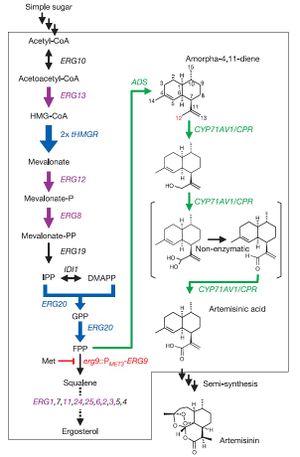CH391L/S12/Artemisinic Acid Engineering: Difference between revisions
From OpenWetWare
Jump to navigationJump to search
No edit summary |
No edit summary |
||
| Line 5: | Line 5: | ||
==Introduction== | ==Introduction== | ||
[[Image:ArtemisnicAcidPathway.jpg|thumb|right|Example application of selectable genetic markers in nematodes. Only nematodes transfected with markers survive and proliferate<cite>Giordano-Santini2011</cite>.]] | |||
==Types of Selectable Markers== | ==Types of Selectable Markers== | ||
Revision as of 16:18, 2 April 2012
- NOTE* Page is still under construction. As long as this note appears, assume information presented on this page is incomplete and unreliable.
Introduction

Types of Selectable Markers
Antibiotic
Herbicidal
Auxotrophic
Other
Types of Screening
Blue/White Screening
Green Fluorescent Protein Screening
Artificial Selection
Previous iGEM Examples
There has been no incidence of previous iGEM teams investigating Artemisinin or any of its precursors. Many iGEM teams have referenced Ro et al., but only as an example of pathway engineering, or in order to discuss ethics and synthetic biology's potential to positively benefit society. No parts in the parts registry deals with Artemisinin either. Only one [set of parts] mentions a protein, Granulysin, which can potentially be used to fight Malaria.
http://en.wikipedia.org/wiki/Artemisinin
References
- Ro DK, Paradise EM, Ouellet M, Fisher KJ, Newman KL, Ndungu JM, Ho KA, Eachus RA, Ham TS, Kirby J, Chang MC, Withers ST, Shiba Y, Sarpong R, and Keasling JD. Production of the antimalarial drug precursor artemisinic acid in engineered yeast. Nature. 2006 Apr 13;440(7086):940-3. DOI:10.1038/nature04640 |
- Chang MC, Eachus RA, Trieu W, Ro DK, and Keasling JD. Engineering Escherichia coli for production of functionalized terpenoids using plant P450s. Nat Chem Biol. 2007 May;3(5):274-7. DOI:10.1038/nchembio875 |